Sweet dreams.
The Mario & Luigi series of RPG’s have had its vicissitudes. Superstar Saga is widely regarded as an achievement in game design and a breakthrough success for Nintendo and AlphaDream. Its successor, Partners in Time, fared less well, struggling with finding itself an identity or anything that made the first game so memorable. It rebounded with Bowser’s Inside Story, which gave the player control of not only the titular Mario Bros. but also Bowser, who possesses his own attack schemes, altering the gameplay significantly and offering up some much-needed variety to the traditional Mario & Luigi formula. Dream Team is the fourth entry to the Mario & Luigi series, and while it mostly succeeds in trying to replicate the fresh feeling of Bowser’s Inside Story, it struggles in many respects that prevents it from being as great as one would hope.
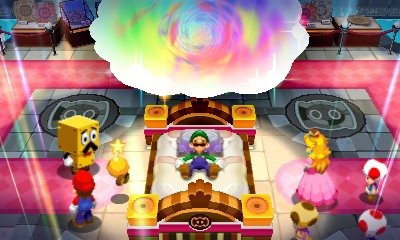
Let us travel into the Dream World!
For those unfamiliar, the Mario & Luigi games are, at their core, traditional turn-based RPG’s. What makes the franchise unique is how the turn-based battles execute. The key to success is timing; attacking the enemy requires precisely timed button presses in order to inflict the most damage. The Mario Bros. can even choose which type of attack they want to use: the two basic attacks jump and hammer, or a Bros. Move, which gives players a set of complex commands to execute, but if done successfully inflicts massive damage. Players are also able to dodge enemy attacks with their jumps and hammers by carefully following enemy cues, which is something I personally greatly appreciate given that most other turn-based RPG’s render the player useless during the enemy turn. Another departure from the traditional RPG formula is the lack of random encounters; all enemies are seen on the game’s overworld, and Mario and Luigi can even attack them beforehand to gain an instant advantage at the start of the battle.
Battles seem to be more complex in Dream Team than in previous entries. For one, it is not uncommon to see enemies attack from the background towards the foreground. The effect I assume is to add depth to the battlefield given the 3DS’ stereoscopic features. Boss battles utilize this feature exceptionally well, and it adds a cool twist to the existing Mario & Luigi formula. Secondly, enemy attacks feel much longer than before. This makes each enemy encounter feel more like a minigame than a minor scuffle – indeed, it even suggests so on the back of the box. This is great because it adds much more complexity to a relatively simple idea, but there is a small problem: in-game achievements push players to perform multiple battles in a row flawlessly, and an increase in complexity in enemy attack patterns makes it very difficult for achievement hunters. Nevertheless, the game as a whole is excellently paced; throughout my 30+ hours of gameplay, I rarely felt overwhelmed by the game’s challenges, nor did I ever feel underpowered.
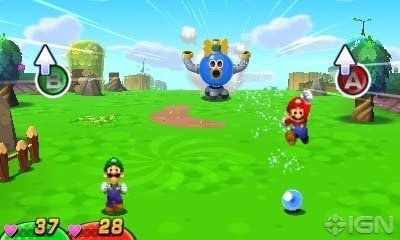
The bosses show off how complex battles can be.
The world in which players explore is adequately large. Those who remember Superstar Saga’s sprawling overworld will be disappointed to find that Dream Team’s main map has very little secrets to hide. The path feels relatively linear this time, and the sense of exploration is somewhat lost in the process. That is not to say that it is not still fun to roam about the map and trying to find the few out-of-sight item boxes, destroying every enemy in your path. The overworld also houses some clever puzzles that involve platforming and activating items (mostly by using the Bros.’ hammers). These to me are some of the most satisfying parts of the game; in a way, the overworld is like a giant top-down Zelda dungeon, and solving them does take some amount of thinking skill.
It is a shame then that the same cannot be said about the Dream World, which is where about half of the game takes place. You see, when the Mario Bros. and Princess Peach arrive on Pi’illo Island for a vacation, the nightmare creature Antasma has escaped his prison while the rest of the Pi’illo folk remain trapped in their dreams. Thus, scattered throughout Pi’illo Island are little stone pillows, which, if Luigi sleeps on them, allows Mario to transport into the Dream World and meet Luigi’s more self-confident alter ego, Dreamy Luigi. Unlike the regular overworld, the Dream World is played from 2D side-scrolling perspective, meaning Mario and Dreamy Luigi can only move left and right. Battles also play out differently within the Dream World; Mario’s attacks now hurt multiple enemies at once, which is helpful given that the enemies now come in hordes. At the same time, however, this significantly increases the time it takes to take out enemies, and enemy attacks can drag on for what seems like forever. Still, this added complexity forces players to change their strategies, giving rise to new ways to play and some much-appreciated variety.
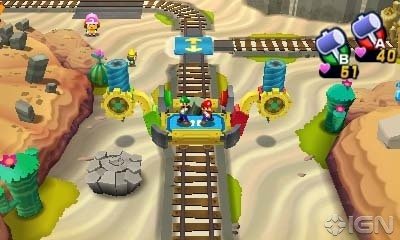
Many of the overworld puzzles are fun and clever...
However, I do have several problems with the Dream World. First off, the puzzles do not feel as intelligently designed. Many of the puzzles in the Dream World involve players either messing with Luigi’s face on the touch screen (which is admittedly amusing the first time you do it) or cloning the Luigi in the dream world into a formation like a stack or a drill. The concept is interesting, but the fact that players are now stuck on a 2D plane makes maneuvering through the puzzles feel both tiresome and tedious. There are a few clever puzzles here and there, but the large majority of the puzzles in the Dream World feel gimmicky and seem to only exist for the sake of adding even more variety to the game (which is fine, but unnecessary at this point). I can appreciate them more if they were done in a way that was enjoyable, but I found myself trudging through the Dream World and wishing to simply return to the overworld and explore. Speaking of which, another problem I have with the Dream World is that it lacks a sense of place; because Luigi is essentially knocked out on a section of the overworld, no real exploration or progression is being done. The Dream World is not even a dark clone of the overworld, but rather a set of rooms that hold little more than floating platforms and obstacles. Only one location later on in the game attempts to create an interesting setting within the Dream World, and it really does make a significant difference in terms of player enjoyment. Why then did AlphaDream not bother to create equally memorable levels in the other dream locations?
Another feature of the Dream World is the occasional giant Luigi battle, similar to the giant Bowser battles in Bowser’s Inside Story. In these battles, players turn the 3DS sideways and control a giant Luigi by inputting commands on the touchscreen. While I personally feel indifferent about the battles themselves (they feel a bit gimmicky, requiring players to swipe and tap the touchscreen to execute attacks), what they do show is just how beautifully animated the game is. Whoever created these set pieces really took the time to construct these worlds into something truly remarkable, reminding me that given the right tools even the 3DS can pump out some incredible visuals. Speaking of which, the sprite work present in this game is amazingly well done, with each character intricately animated to the minutest detail. The overworld itself is actually composed of 3D polygons – a first for the series – and the 3D effect looks great. It is not hard to say that Mario & Luigi: Dream Team is one of the best-looking 3DS game around.
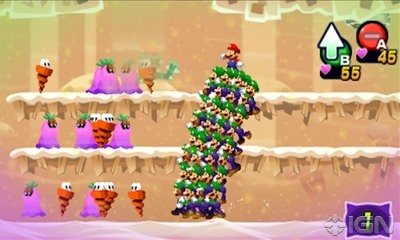
... but the same cannot be said about the Dream World ones.
The many other aspects of Dream Team’s presentation are equally as impressive. The game’s soundtrack is very good, which is expected given composer Yoko Shimamura’s track history with video game music. One thing I did notice was some audio tearing from the 3DS’ speakers here and there, which is a bit strange, but it did not detract from the overall experience. The writing is, as with the other Mario & Luigi games, very witty and funny, though I could probably do without Starlow’s incessant, sarcastic bantering, which I find very annoying. What is even more annoying is the fact that he and Price Dreambert never stop giving tutorials to the player. A big part of what made the previous games so much fun is that they allowed you to experiment and try different ways to solve each puzzle yourself; in this game, the solution is practically handed to you, making the game not only less challenging, but also feel more like a chore. Thankfully, most of the tutorials are front-loaded, and by the end of the game you begin to feel like you have more freedom in your choices, but the amount of handholding for a game like this is ridiculous.
Despite these missteps, I still very much enjoyed my time with Mario & Luigi: Dream Team. It may not be as great as the original Superstar Saga, but it does carry the same spirit and humor that makes the series so special. The Dream World is an interesting twist to the traditional Mario & Luigi formula, but its most impressive moments are undermined by the flawed, fundamental nature of the very idea. The core of the game remains the same as before, though battles feel a bit more complex this time around. In terms of presentation, the game hits it through the roof, but its tutorial and text-heavy first half do get in the way of the experience. Overall, fans of the series will definitely find much enjoyment in this title, and those who want to experience Mario & Luigi for the first time will easily gain an understanding of what makes this franchise so beloved and great.
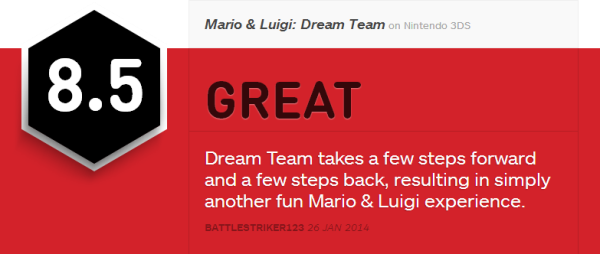
![Amazing Spider-Man Finale Features New [SPOILER] Costume](../../../../../../assets1.ignimgs.com/2018/06/01/untitled-br-1527892808294_small.jpg)